CHEVROLET TRAIL BLAZER 2002 1.G Workshop Manual
Manufacturer: CHEVROLET, Model Year: 2002, Model line: TRAIL BLAZER, Model: CHEVROLET TRAIL BLAZER 2002 1.GPages: 432, PDF Size: 2.84 MB
Page 51 of 432
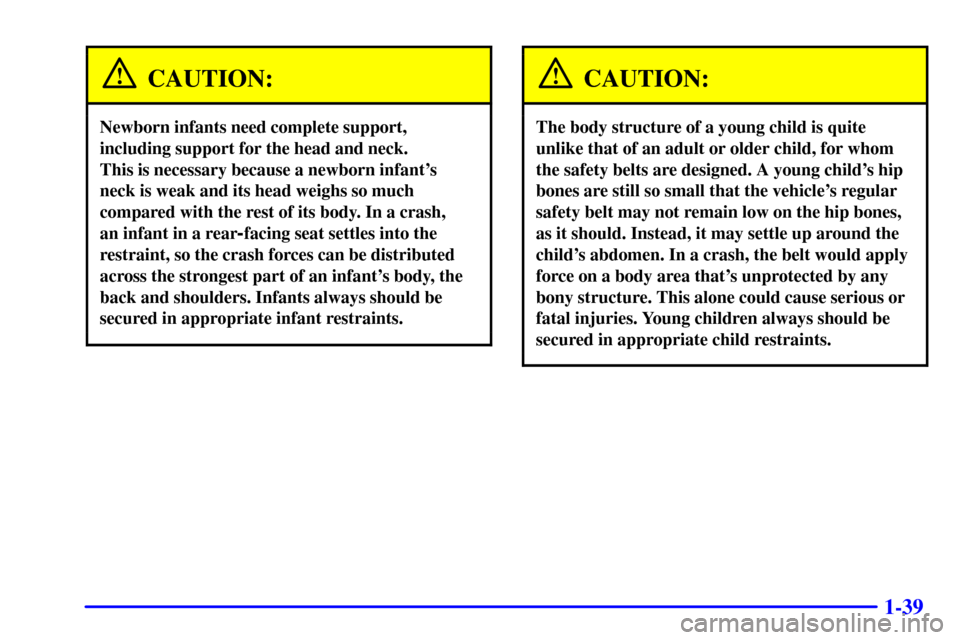
1-39
CAUTION:
Newborn infants need complete support,
including support for the head and neck.
This is necessary because a newborn infant's
neck is weak and its head weighs so much
compared with the rest of its body. In a crash,
an infant in a rear
-facing seat settles into the
restraint, so the crash forces can be distributed
across the strongest part of an infant's body, the
back and shoulders. Infants always should be
secured in appropriate infant restraints.
CAUTION:
The body structure of a young child is quite
unlike that of an adult or older child, for whom
the safety belts are designed. A young child's hip
bones are still so small that the vehicle's regular
safety belt may not remain low on the hip bones,
as it should. Instead, it may settle up around the
child's abdomen. In a crash, the belt would apply
force on a body area that's unprotected by any
bony structure. This alone could cause serious or
fatal injuries. Young children always should be
secured in appropriate child restraints.
Page 52 of 432
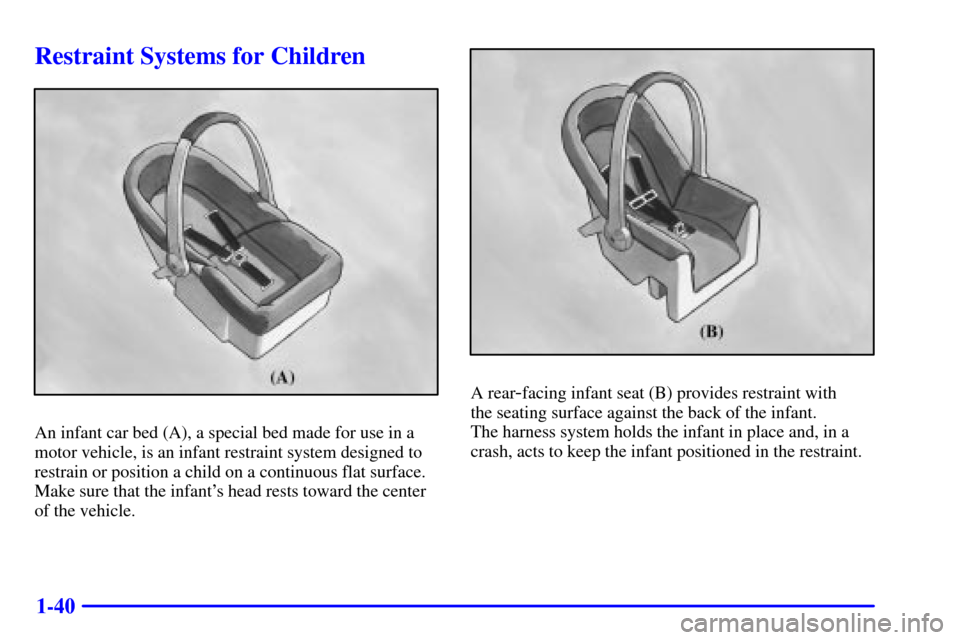
1-40
Restraint Systems for Children
An infant car bed (A), a special bed made for use in a
motor vehicle, is an infant restraint system designed to
restrain or position a child on a continuous flat surface.
Make sure that the infant's head rests toward the center
of the vehicle.
A rear-facing infant seat (B) provides restraint with
the seating surface against the back of the infant.
The harness system holds the infant in place and, in a
crash, acts to keep the infant positioned in the restraint.
Page 53 of 432
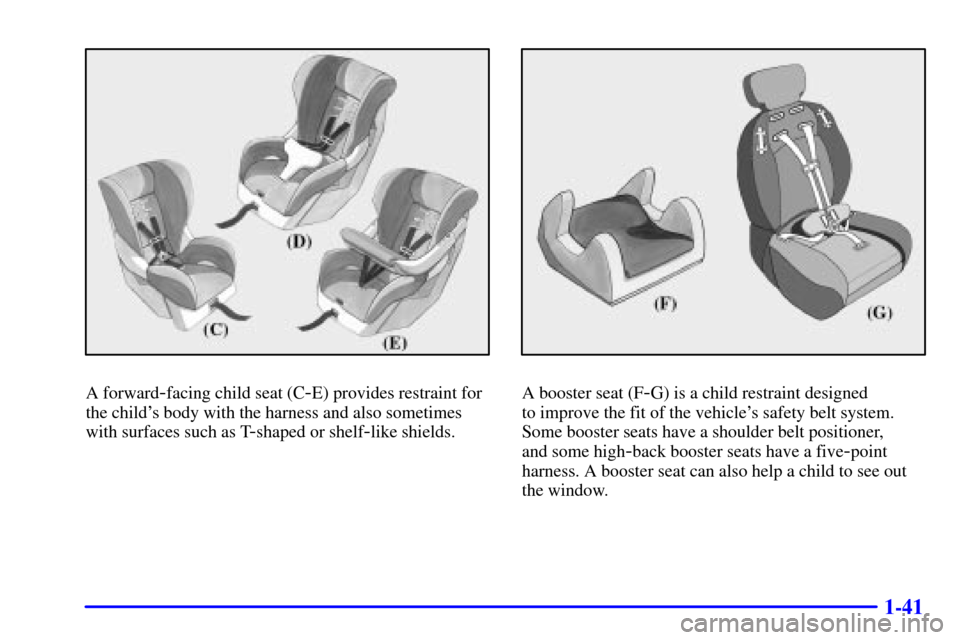
1-41
A forward-facing child seat (C-E) provides restraint for
the child's body with the harness and also sometimes
with surfaces such as T
-shaped or shelf-like shields.
A booster seat (F-G) is a child restraint designed
to improve the fit of the vehicle's safety belt system.
Some booster seats have a shoulder belt positioner,
and some high
-back booster seats have a five-point
harness. A booster seat can also help a child to see out
the window.
Page 54 of 432

1-42
Q:How do child restraints work?
A:A child restraint system is any device designed for
use in a motor vehicle to restrain, seat, or position
children. A built
-in child restraint system is a
permanent part of the motor vehicle. An add
-on
child restraint system is a portable one, which is
purchased by the vehicle's owner.
For many years, add
-on child restraints have used
the adult belt system in the vehicle. To help reduce
the chance of injury, the child also has to be
secured within the restraint. The vehicle's belt
system secures the add
-on child restraint in the
vehicle, and the add
-on child restraint's harness
system holds the child in place within the restraint.
One system, the three
-point harness, has straps that
come down over each of the infant's shoulders and
buckle together at the crotch. The five
-point
harness system has two shoulder straps, two hip
straps and a crotch strap. A shield may take the
place of hip straps.A T
-shaped shield has shoulder straps that are
attached to a flat pad which rests low against the
child's body. A shelf
- or armrest-type shield has
straps that are attached to a wide, shelf
-like shield
that swings up or to the side.
When choosing a child restraint, be sure the child
restraint is designed to be used in a vehicle. If it is,
it will have a label saying that it meets federal motor
vehicle safety standards.
Then follow the instructions for the restraint. You may
find these instructions on the restraint itself or in a
booklet, or both. These restraints use the belt system in
your vehicle, but the child also has to be secured within
the restraint to help reduce the chance of personal injury.
When securing an add
-on child restraint, refer to the
instructions that come with the restraint which may be
on the restraint itself or in a booklet, or both, and to this
manual. The child restraint instructions are important, so
if they are not available, obtain a replacement copy from
the manufacturer.
Page 55 of 432
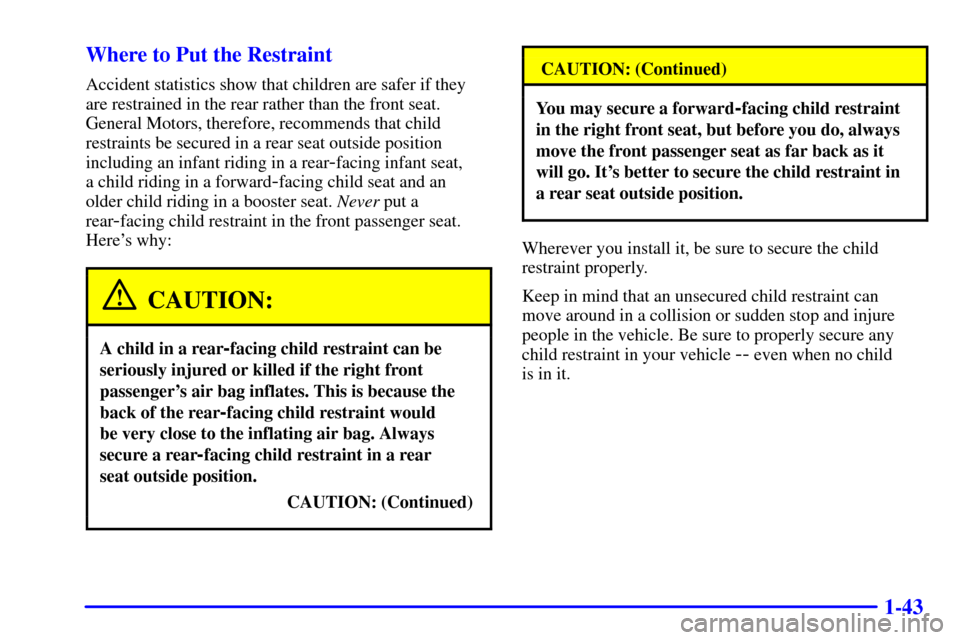
1-43 Where to Put the Restraint
Accident statistics show that children are safer if they
are restrained in the rear rather than the front seat.
General Motors, therefore, recommends that child
restraints be secured in a rear seat outside position
including an infant riding in a rear
-facing infant seat,
a child riding in a forward
-facing child seat and an
older child riding in a booster seat. Never put a
rear
-facing child restraint in the front passenger seat.
Here's why:
CAUTION:
A child in a rear-facing child restraint can be
seriously injured or killed if the right front
passenger's air bag inflates. This is because the
back of the rear
-facing child restraint would
be very close to the inflating air bag. Always
secure a rear
-facing child restraint in a rear
seat outside position.
CAUTION: (Continued)
CAUTION: (Continued)
You may secure a forward-facing child restraint
in the right front seat, but before you do, always
move the front passenger seat as far back as it
will go. It's better to secure the child restraint in
a rear seat outside position.
Wherever you install it, be sure to secure the child
restraint properly.
Keep in mind that an unsecured child restraint can
move around in a collision or sudden stop and injure
people in the vehicle. Be sure to properly secure any
child restraint in your vehicle
-- even when no child
is in it.
Page 56 of 432
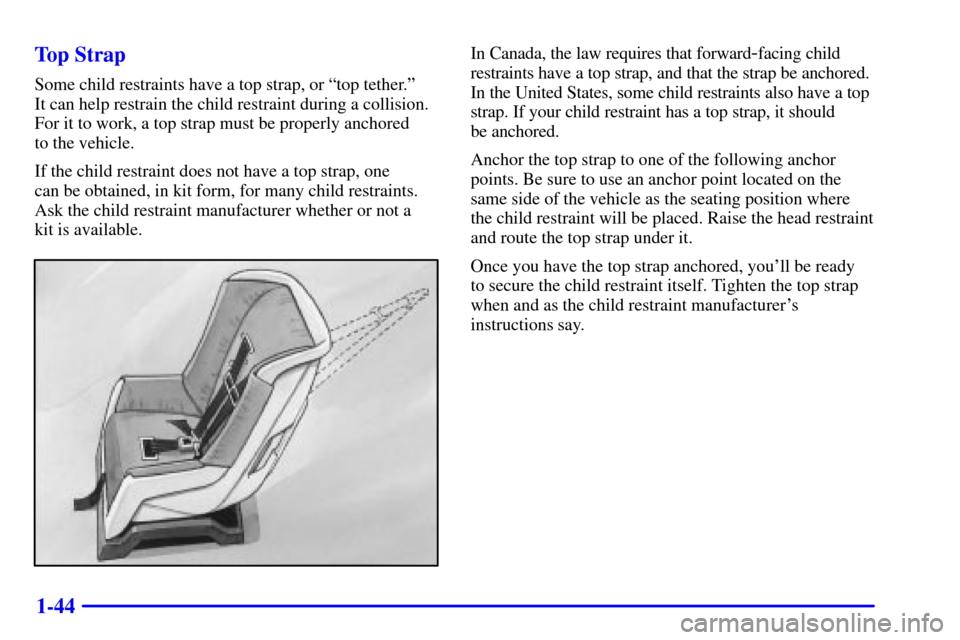
1-44 Top Strap
Some child restraints have a top strap, or ªtop tether.º
It can help restrain the child restraint during a collision.
For it to work, a top strap must be properly anchored
to the vehicle.
If the child restraint does not have a top strap, one
can be obtained, in kit form, for many child restraints.
Ask the child restraint manufacturer whether or not a
kit is available.
In Canada, the law requires that forward-facing child
restraints have a top strap, and that the strap be anchored.
In the United States, some child restraints also have a top
strap. If your child restraint has a top strap, it should
be anchored.
Anchor the top strap to one of the following anchor
points. Be sure to use an anchor point located on the
same side of the vehicle as the seating position where
the child restraint will be placed. Raise the head restraint
and route the top strap under it.
Once you have the top strap anchored, you'll be ready
to secure the child restraint itself. Tighten the top strap
when and as the child restraint manufacturer's
instructions say.
Page 57 of 432
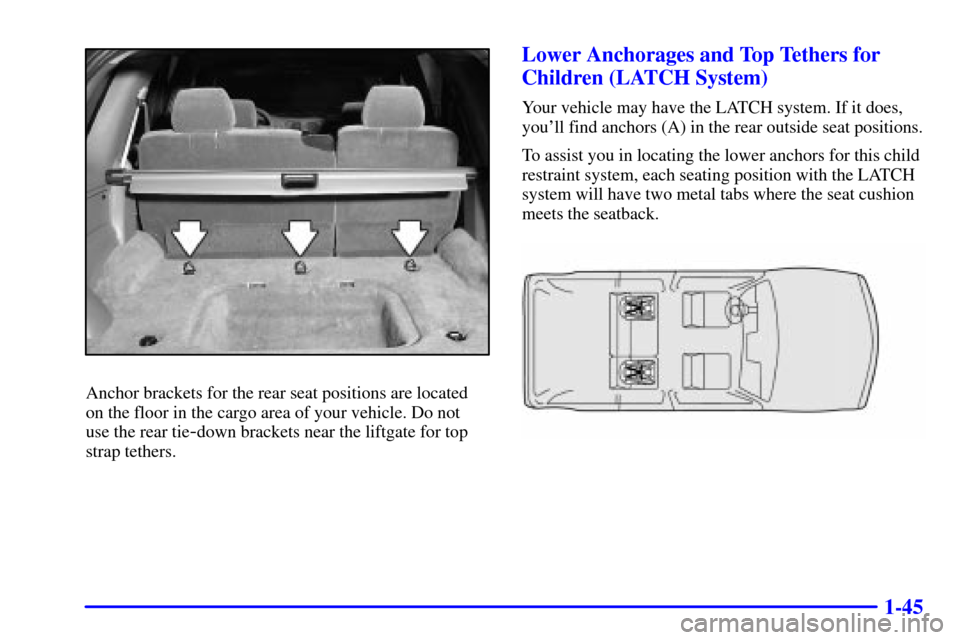
1-45
Anchor brackets for the rear seat positions are located
on the floor in the cargo area of your vehicle. Do not
use the rear tie
-down brackets near the liftgate for top
strap tethers.
Lower Anchorages and Top Tethers for
Children (LATCH System)
Your vehicle may have the LATCH system. If it does,
you'll find anchors (A) in the rear outside seat positions.
To assist you in locating the lower anchors for this child
restraint system, each seating position with the LATCH
system will have two metal tabs where the seat cushion
meets the seatback.
Page 58 of 432
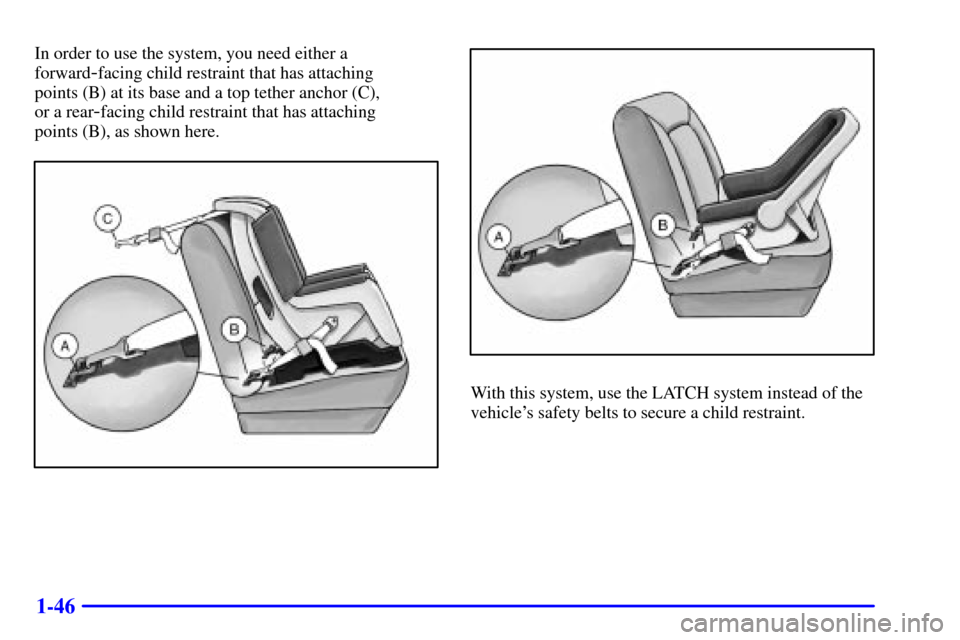
1-46
In order to use the system, you need either a
forward
-facing child restraint that has attaching
points (B) at its base and a top tether anchor (C),
or a rear
-facing child restraint that has attaching
points (B), as shown here.
With this system, use the LATCH system instead of the
vehicle's safety belts to secure a child restraint.
Page 59 of 432
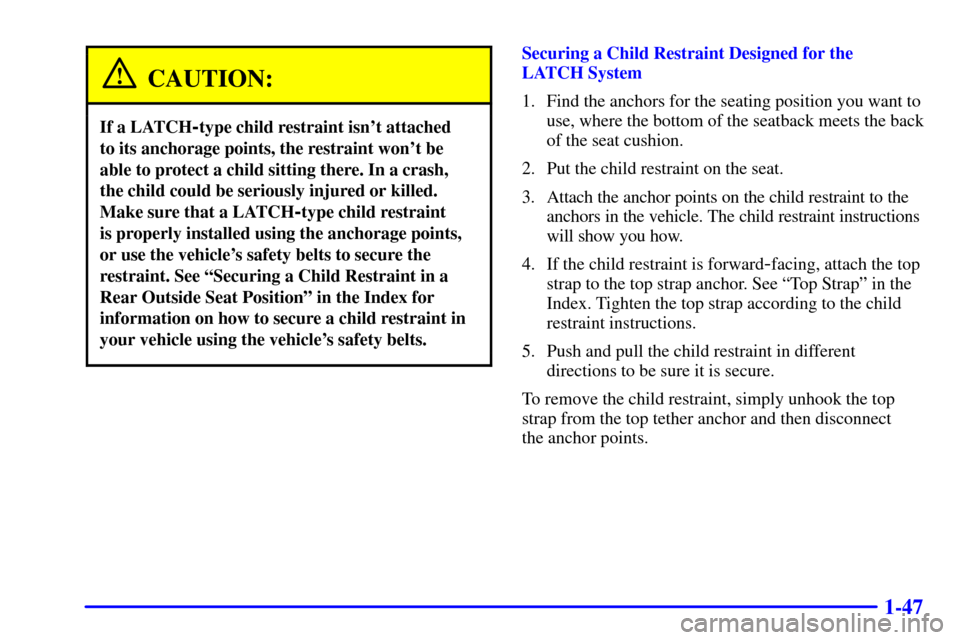
1-47
CAUTION:
If a LATCH-type child restraint isn't attached
to its anchorage points, the restraint won't be
able to protect a child sitting there. In a crash,
the child could be seriously injured or killed.
Make sure that a LATCH
-type child restraint
is properly installed using the anchorage points,
or use the vehicle's safety belts to secure the
restraint. See ªSecuring a Child Restraint in a
Rear Outside Seat Positionº in the Index for
information on how to secure a child restraint in
your vehicle using the vehicle's safety belts.
Securing a Child Restraint Designed for the
LATCH System
1. Find the anchors for the seating position you want to
use, where the bottom of the seatback meets the back
of the seat cushion.
2. Put the child restraint on the seat.
3. Attach the anchor points on the child restraint to the
anchors in the vehicle. The child restraint instructions
will show you how.
4. If the child restraint is forward
-facing, attach the top
strap to the top strap anchor. See ªTop Strapº in the
Index. Tighten the top strap according to the child
restraint instructions.
5. Push and pull the child restraint in different
directions to be sure it is secure.
To remove the child restraint, simply unhook the top
strap from the top tether anchor and then disconnect
the anchor points.
Page 60 of 432
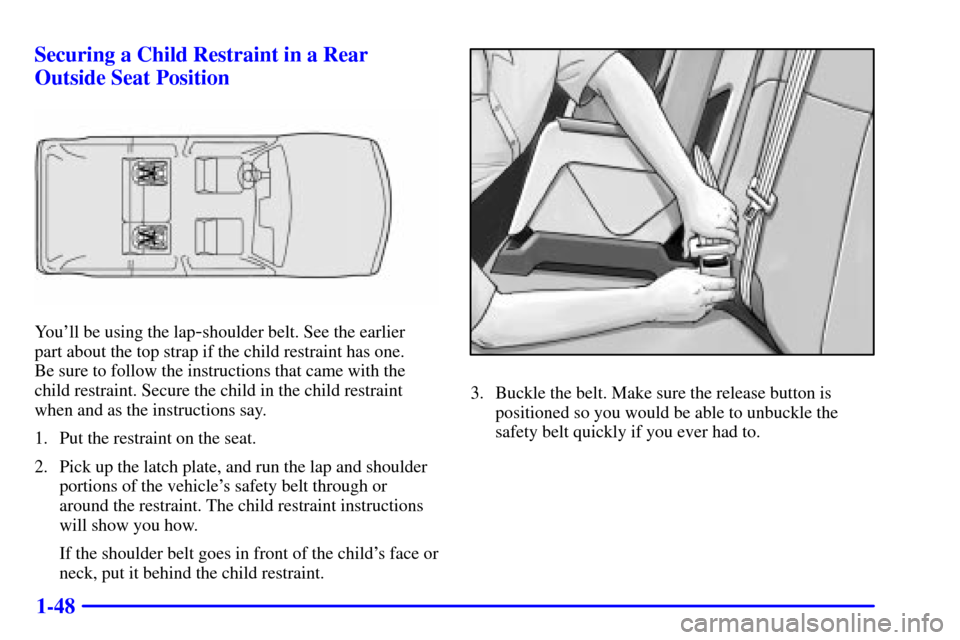
1-48 Securing a Child Restraint in a Rear
Outside Seat Position
You'll be using the lap-shoulder belt. See the earlier
part about the top strap if the child restraint has one.
Be sure to follow the instructions that came with the
child restraint. Secure the child in the child restraint
when and as the instructions say.
1. Put the restraint on the seat.
2. Pick up the latch plate, and run the lap and shoulder
portions of the vehicle's safety belt through or
around the restraint. The child restraint instructions
will show you how.
If the shoulder belt goes in front of the child's face or
neck, put it behind the child restraint.
3. Buckle the belt. Make sure the release button is
positioned so you would be able to unbuckle the
safety belt quickly if you ever had to.